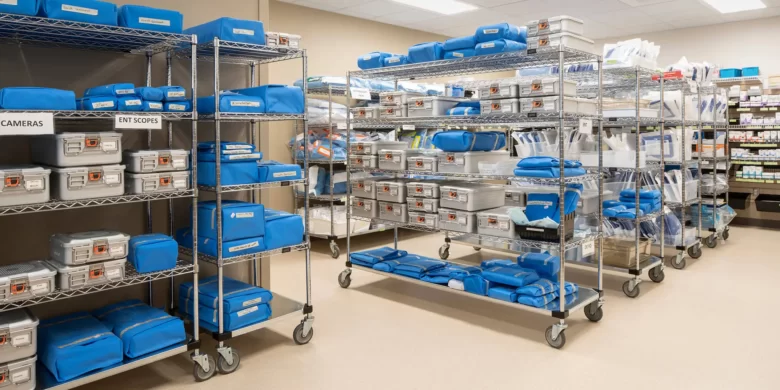Medical Equipment Guide: The Importance of Safe Storage and Transportation
Contents
As fast-paced and high-pressure as the hospital environment is, it can get pretty chaotic at times. You’ve got doctors and nurses running around attending to patients, with a few visitors thrown into the mix. If everything isn’t properly organised, it can quickly turn into a madhouse.
With much of the focus being on providing the best possible care for patients, the role that durable and reliable medical equipment plays in a hospital is often considered an afterthought. Sure, the human factor is important, but without the right tools, they wouldn’t be able to do their jobs as effectively.
The Importance of Medical Equipment in a Hospital
There’s no doubt that being properly equipped with medical supplies is an integral part of providing quality care in a hospital. After all, how can doctors and nurses be expected to do their jobs properly if they don’t have the right tools?
While it’s easy to take for granted, medical tools are specifically designed to help with the diagnosis and treatment of patients. Healthcare professionals rely on them to do everything from taking vital signs to performing surgery.
Think of it this way – would you trust a mechanic to fix your car if they didn’t have the tools to do so? Of course not, and the same principle applies to hospitals as well, but by much more important stakes.

source: pinimg.com
What Equipment Does a Hospital Need?
Aside from the basic diagnostic and treatment tools, hospitals can make use of a variety of different types of equipment to help make their day-to-day operations run more smoothly. The specifics regarding these items will depend on the size and type of hospital, but some common examples include:
Multi-Purpose Trolleys
Given the large-scale nature of hospital buildings and the numerous departments within them, it’s not uncommon for staff members to have to transport supplies from one end of the hospital to the other. And, oftentimes, they can be quite bulky and heavy.
In order to make this process as efficient as possible, healthcare workers make use of multi-purpose medical equipment like trolleys with numerous shelves and drawers. This way, they can transport everything they need in a single trip and free up their hands for other tasks.
Most trolleys are made of stainless steel for easy cleaning and maintenance, with some models even featuring built-in power outlets to charge medical devices on the go. The shelves and drawers are also adjustable so that they can accommodate items of different sizes.
Waste Bins and Tippers
On any given day, a hospital will generate a huge amount of waste – from used gloves and needles to soiled linen. Not only is it important to dispose of this waste properly for hygiene reasons, but some items may also pose a safety hazard if not handled correctly.
With that in mind, hospitals use specially designed waste bins and tippers to safely collect and store medical waste. These plastic bins are typically colour-coded, with red being used for items that require special handling such as sharps and blue for general waste.
The bins are lined with a thick plastic bag that is then sealed shut and disposed of when full. Each bin also has a foot pedal, so that staff members can open and close the lid without having to touch it directly.
The tippers, on the other hand, are designed for easy emptying and come in a variety of sizes to accommodate different types of bins. They’re basically a large metal frame with wheels that can be tipped up to allow the waste bin to be emptied into a larger container.
Platform Lifters
Hospitals are places where people of all ages and abilities come for treatment, ranging from newborn babies to elderly patients. As such, it’s important for these institutions to be accessible to everyone, which is where platform lifters come in.
Also known as patient lifts, these devices are used to safely transport patients who are unable to walk on their own. They essentially work like a large-scale version of a standard chair lift, with a seat or sling that the patient is strapped into.
Platform lifts may have varying features and designs, but most of them include a hydraulic system that allows the user to raise and lower the patient with ease. Some models also come with extra features such as built-in scale or rotating seats, which can be helpful for certain patients.
Storage Cabinets and Plastic Crates
With all of the different hospital supplies and medications that healthcare professionals need to keep on hand, having a well-planned storage system is crucial. Otherwise, it would be all too easy for things to get lost or misplaced.
One of the most common storage units used in these settings are cabinets, which can have a plethora of extra features depending on the needs of the hospital. For example, some cabinets are designed to be fireproof, while others have specialised compartments for storing hazardous materials.
Plastic crates are also commonly used, as they offer a lightweight and versatile storage solution. They can be easily stacked on top of each other when they’re not needed, and some models even come with wheels for easy transportation.
Barriers and Ramps
These handy devices are often used in conjunction with platform lifts, as they help create a smooth and level surface for the patient to be transported on. Barriers are essentially large pieces of equipment that can be placed around a bed or wheelchair, while ramps can be used to bridge any gaps or steps.
The aluminium construction of most barriers and ramps is quite sturdy yet still light enough to be moved around as needed. They’re also usually fitted with non-slip surfaces to help prevent any accidents.






